
St Andrew's Uniting Church, Bendigo: exterior from north
(Photograph by John Maidment [January 2018])

St Andrew's Uniting Church, Bendigo: exterior from north
(Photograph by John Maidment [January 2018])
Historical and Technical Documentation by John Maidment
© OHTA, 2018 (last updated January 2018)
The first St Andrew's Church, built in stone, was opened on 19 January 1859 and was demolished in early 1930. The present St Andrew's Church was erected in that year. The foundation stone was laid on 22 March 1930 and the building dedicated on 30 November 1930. The cost exceeded £10,000. The architects were George Dawson Garvin FRVIA and Godfrey Eathorne, both of whom practised in Bendigo.1 It consists of a broad nave, with passage aisles, transepts and sanctuary. The organ chamber, of generous proportions, is placed in the south-west corner. The building contains an outstanding collection of stained glass by Brooks Robinson and Mathieson & Gibson.
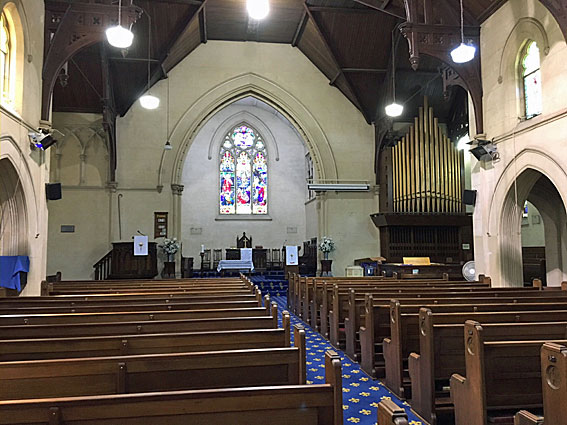
St Andrew's Uniting Church, Bendigo: interior from rear of nave
(Photograph by John Maidment [January 2018])
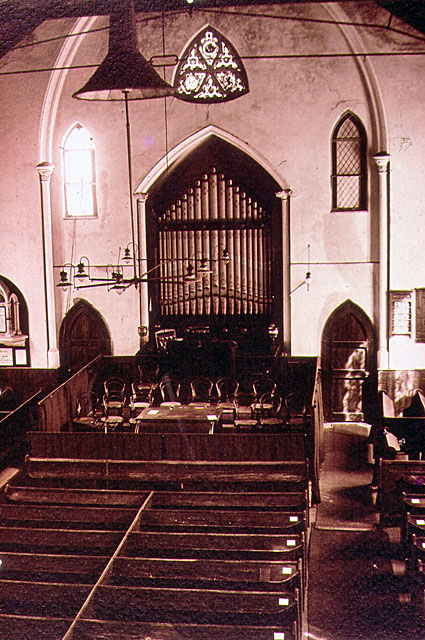
St Andrew's Uniting Church, Bendigo: Alfred Fuller organ from rear gallery
(Photographer unknown [after 1894])
The first pipe organ was built by Alfred Fuller, one of his first Australian contracts. It is well described in several press accounts:
The new organ which is to be opened on Thursday evening at St. Andrew's Presbyterian Church will be a valuable addition to the choral services of the church. It will be complete in every particular, and will be a great improvement on the one now in use, but which did good service for so many years, Mr.Fuller, of Kew, the builder, is evidently a very conscientious worker, all the details having been carried out in such a manner that nothing but unqualified praise can be given him. One noticeable feature. In the organ is the noiselessness of the action work, especially of the pedals and bellows. In a great any organs the rattle of the pedals, and the banging of the bellows' tongues, are very objectionable in the soft passages. Mr. Fuller has entirely surmounted this difficulty, and the softest passages can be executed without any other sound than the music itself. Another improvement, and, we believe Mr. Fuller's own invention, is a convenient plan of opening the swell, the old clumsy plan of pressing the swell pedal down, and then drawing it back into the groove is done away with, and all that the performer has to do is simply to press down the pedal, and a self-acting spring catches it immediately. The front of the organ is without doubt very handsome, the decorations being picked out in gold and tints. The following are the specifications:—Two manuals, compass CC to Gin alt. 56 notes with an independent pedal organ of 30 notes CCC to F. Great—Open diapason CC 8 foot, stopped diapason, clarabella, dulciana, principal 4 feet; flute, 4 feet; twelfth, 2⅔ feet; fifteenth, 2 feet. Swell— Open diapason, 8 feet; stopped bass, gedackt, 8 feet; gemshorn, 4 feet, piccolo, 2 feet; oboe, 8 feet. Pedal organ, 30 notes CCC to F; bourdon, 16 feet. Couplers —Swell to great, swell to pedals, great to pedals, Three composition pedals to great,
The Bendigo Advertiser, 10 May 1882, p.3
The new organ at St. Andrew's Presbyterian Church, built by Mr. A. Fuller, of Kew, was opened this evening. The church was crowded, some 700 persons being present. The organ was opened by Mr.Charles Sykes, of Melbourne, who showed the beautiful instrument off to advantage in several exquisitely played solo performances. The cantata, "Placida," was performed by a number of local amateur singers, the chorus consisting of St. Andrew's choir and a number of friends, about 70 altogether, under the conductorship of Mr. A. T. Crook.
The Argus 12 May 1882, p.7
In 1894, the keyboards were extended forward by 20 feet to a detached console, this work carried out by John B. Crook, the brother of Alfred T. Crook, the organist of the church.2
Geo. Fincham & Son carried out modifications to the organ in 1917:
The organ at St. Andrew's has been for some weeks past in the hands of Messrs. Fincham and Son, organ builders, Richmond, for alterations and repairs, and new electric motor and fan for the supply of wind. Two new sound boards for both great and swell organs have been built, the action of the same having received thorough attention as regards the pallets and springs, etc. The bellows and French feeders have been re-leathered. Pipe work has received special attention, the metal pipes have been transposed and new pipes added, with new slides for tuning, the wooden pipes repaired and strengthened, and new feet added where necessary. The action and touch have received a thorough overhaul, and the response is now most satisfactory. The stop and composition action is greatly improved. The reed stops have been re-voiced. The English electric motor by Witton and fan has been erected in a new chamber at the back of the present organ chamber, and is working very smoothly. The whole of the organ work was under Mr. J. T. Warren, organist and choirmaster, representing the Board of Management. The organ will he re-opened on Sunday next July 1, and at the close of the evening service an organ recital and vocal items will be given by the organist and choir.
The Bendigo Independent, 29 June 1917, p. 2
The organ in St. Andrew's Church has for some weeks past been undergone alterations and repairs, and fitted with a new electric motor and fan for the supply of wind. Two new sound-boards for both great and swell organs have been built the action of the same having received thorough attention as regards the pallets, springs, etc. The bellows and French feeders have been releathered. Pipe work has received special attention. The metal pipes have been transposed and new pipes added, with new slides for tuning, the wooden pipes repaired and strengthened, and new feet added where necessary. The action and touch have received a thorough overhaul, and the response is now most satisfactory. The stop and composition action is greatly improved. The reed stops have been revoiced. The English electric motor and fan have been erected in a new brick chamber at the back of the present organ chamber, and is working very smoothly. The organ has been cleaned from to bottom. The motor chamber was built under the superintendence of Mr. G. D. Garvin. The whole of the organ work was under Mr. J. T. Warren organist and choirmaster representing the board of management in conjunction with Messrs. Taylor and Garvin. The organ will be re-opened next Sunday 31st July, and at the close of the evening service an organ recital and vocal items will be giver, by the organist and choir.
Bendigo Advertiser, 29 June 1917, p.3
The earlier church was demolished in early 1930 and the organ dismantled by R. and C. Cowling. It was stored in the manse and then re-erected in the church in the new organ chamber at floor level, presumably without alteration although it appears that the façade pipes were silvered.
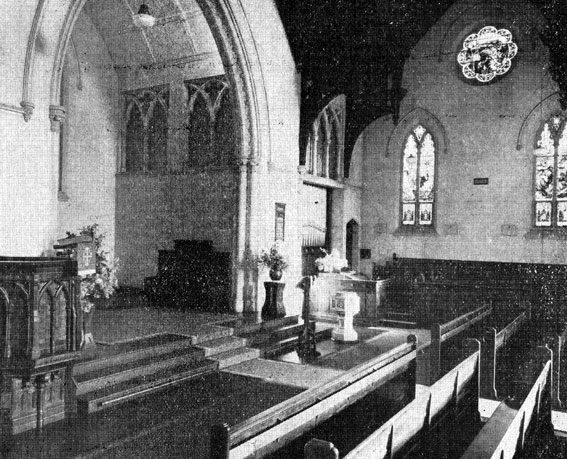
St Andrew's Uniting Church, Bendigo: Alfred Fuller organ after erection in new church
(Centenary Brochure 1854-1954 [c.1954])
In 1959, the organ was rebuilt by Hill, Norman & Beard (Australia) Pty Ltd, the firm's job number V431. This work was very extensive and essentially provided the church with a new instrument. The windchests were raised on a new building frame, a new wind system supplied and a new sliderless windchest for the swell provided. The action was updated to electro-pneumatic and electro-magnetic for the unit chests, and a detached stopkey console supplied. A number of new ranks of pipes were installed, and a new organ case was constructed, incorporating some of the original Fuller façade pipes. At a later stage, John Parker inserted five new pipes at the rear to continue the bottom octave of the Majorbass in wood in place of the five central metal façade pipes made by Hill, Norman & Beard.
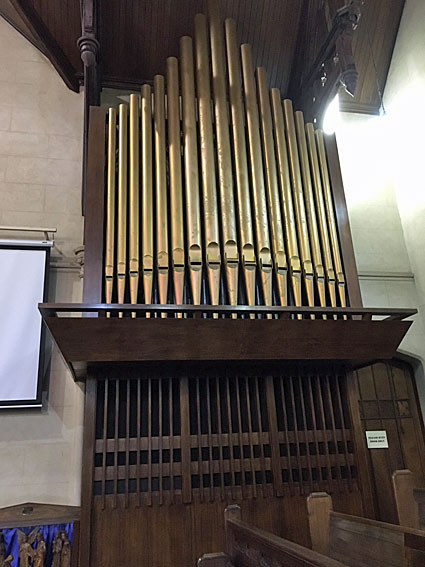
St Andrew's Uniting Church, Bendigo: organ as rebuilt by Hill, Norman & Beard 1959
(Photograph by John Maidment [January 2018])
| GREAT Lieblich Bourdon Open Diapason Claribel Flute Dulciana Octave Nason Flute Nazard Super Octave Larigot Mixture 22.26.29 Trumpet Swell Sub Octave to Great Swell to Great Swell Octave to Great SWELL Geigen Principal Rohr Flöte Salicional Voix Celeste Gemshorn 4 Mixture 15.19.22 Contra Oboe Horn Oboe Octave Oboe Tremulant Sub Octave Unison Off Octave PEDAL Majorbass Bourdon Lieblich Bourdon Grossquint Flute Quint Octave Flute Posaune Great to Pedal Swell to Pedal Swell Octave to Pedal3 |
16 8 8 8 4 4 2-2/3 2 1-1/3 III 8 8 8 8 8 4 III 16 8 8 4 16 16 16 10-2/3 8 5-1/3 4 16 |
A B A A A TC C C C D A D D D D |
HN&B on unit chest Fuller HN&B silky oak treble pipes with metal feet Fuller with HN&B bass Fuller HN&B HN&B Fuller HN&B HN&B HN&B on unit chest (Fuller box with horizontal shutters, extended in canite) Fuller with open wood bass HN&B HN&B HN&B Fuller HN&B Fuller?, 1-12 HN&B, basses protruding through bottom of Swell HN&B Fuller? On unit chest Fuller/HN&B 1-7 HN&B (and John Parker open wood, small scale 8-12), remainder from B Fuller HN&B HN&B HN&B HN&B HN&B HN&B prepared-for only at console |
1 The Story of St Andrew's Church Bendigo 1854-1965, written and collated by Margaret Temple. Newtown, Vic.: Neptune Press, 1984
2 Bendigo Independent, 22 October 1894, p.3
3 Specification noted by John Maidment 1966, updated 2018. Information on the Pedal Majorbass provided by Ian Wakeley 2018.
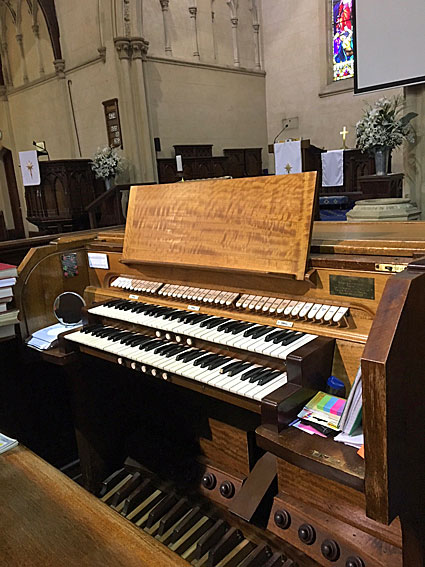
St Andrew's Uniting Church, Bendigo: console by Hill, Norman & Beard 1959
(Photograph by John Maidment [January 2018])
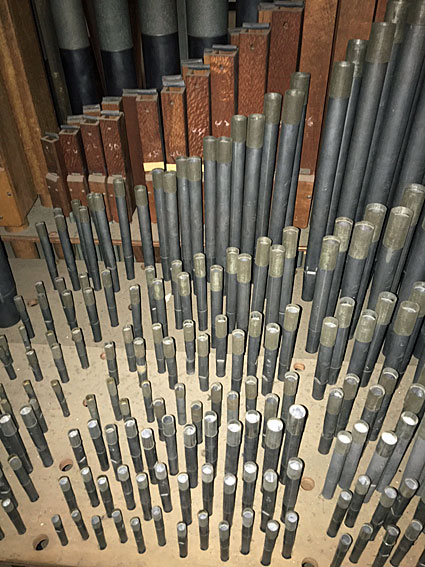
St Andrew's Uniting Church, Bendigo: Great pipework
(Photograph by John Maidment [January 2018])
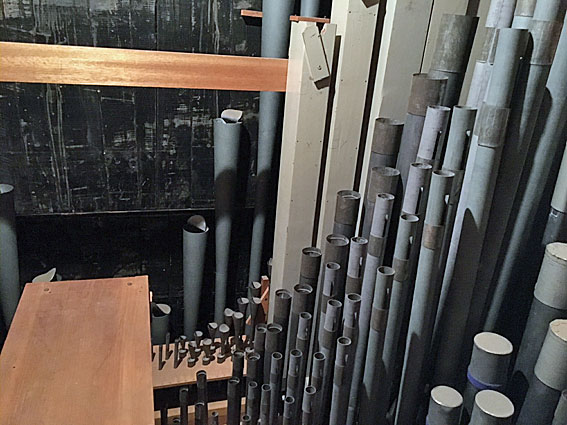
St Andrew's Uniting Church, Bendigo: Swell pipework
(Photograph by John Maidment [January 2018])
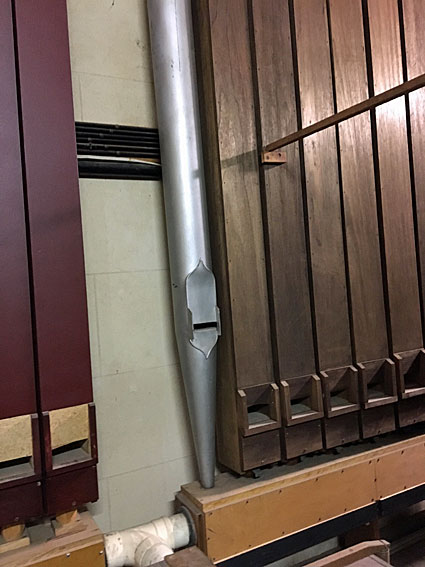
St Andrew's Uniting Church, Bendigo: Pedal Majorbass pipes and an original Fuller façade pipe
(Photograph by John Maidment [January 2018])